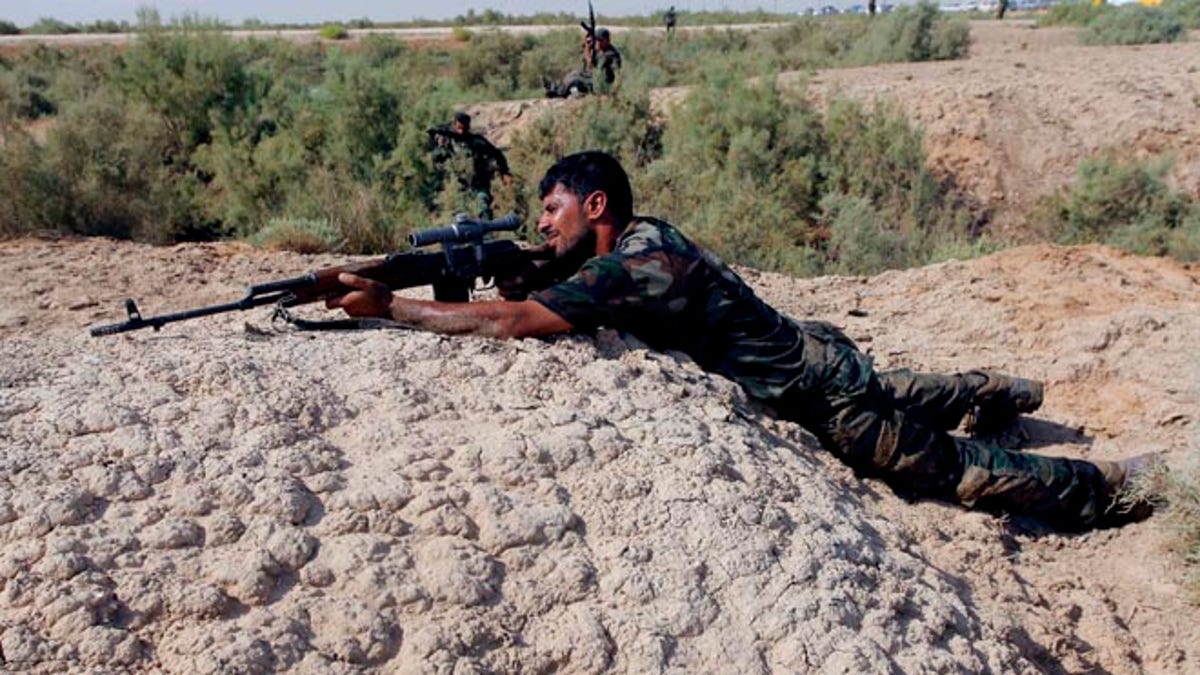
FILE: August 23, 2014: A Shite fighter, who has joined in the fight against Islamic State, taking part in field training in Najaf, Iraq. (REUTERS)
It’s hard to imagine a discussion on the barbarians who make up The Islamic State having anything to do with Goldilocks and the Three Bears. But if Congress is going to approve any formal authorization to sanction U.S. military action against the extremist group, it needs to engineer a resolution that’s not too hot, not too cold, but just right.
And therein lies the challenge.
How does Congress author a resolution that allows lawmakers to exercise their Constitutional authority about deploying U.S. military force -- yet doesn’t fully commit “boots on the ground?”
Lawmakers are leery about the latter because the public long ago lost its appetite for a protracted conflict. Yet at the same time, how does Congress make sure the resolution is muscular enough to actually make a difference in fighting ISIS and not just a fig leaf?
And if Congress doesn’t concoct something that is sufficiently stout, what are the consequences if ISIS hits the United States, keeps incinerating people in cages, lopping off heads or seriously threatens Israel and Jordan?
What is the composition of a resolution that doesn’t hem in the president and the military -- yet gives them appropriate agility to react and respond and fight?
And how about a time frame? How can one possibly say the U.S. is committed only to fighting this long? And if it’s open-ended, some lawmakers fret it’s not appropriate for the U.S. to wage perpetual conflicts that never seem to have exit strategies.
Notice this “resolution” to combat ISIS isn’t even called a “Declaration of War.” It’s euphemistically called an “AUMF,” short for “Authorization for Use of Military Force.” The Constitution grants Congress “war powers. But Congress has officially declared “war” only five times. The most recent was in 1941 when the U.S. entered WWII. The U.S. is very worried about declaring “war” on ISIS, lest it be perceived it’s at “war with Islam” or Muslims. So an “AUMF for ISIS” will just have to do.
Straightforward but curved. Structured but limber. A ceiling but no floor. A floor but no ceiling.
It’s almost Zen-like. Or to Goldilocks, porridge. Not too hot. Not too cold. But just right.
Chatter about crafting a resolution to manage the U.S. fight against ISIS ramped up this week. White House spokesman Eric Schultz indicated that a resolution would come “relatively soon.” Sources tell Fox News that the presentation of a draft resolution could land on Capitol Hill in a number of days.
“It was clear that leaders on the Hill wanted to get this done. It was also clear this was a priority for the president and they wanted language from the White House. They also wanted to be consulted in advance of sending that language up,” said Schultz, who characterized the talks as “robust.”
Some senior lawmakers indicated that the video of the live burning of a Jordanian pilot this week could be the impetus for increased discussions.
“I don’t know how these two things are disconnected,” said one source who spoke on the condition they not be identified.
However, other sources disagreed with that suggestion.
“They’ve been talking about this since State of the Union,” said one source. “This isn’t new.”
Still, another source said that the timing of the increased talk was natural because “they have to give us (a resolution) at some point.” The source noted that additional conversations about a resolution would intensify after President Obama presented his annual budget to Congress.
Obama dropped off his budget on Capitol Hill on Monday. National Security Advisor Susan Rice discussed the finer points of the president’s national security on Friday at the Brookings Institution after the White House sent a copy of the blueprint to the Capitol earlier in the day.
So the resolution appears to be coming together.
But…
“We’ve gotten our hopes up before,” said a source.
House Speaker John Boehner, R-Ohio, has been resolute that such a request come from the White House and not be something engineered by Congress.
Sources have pointed to two prominent proposals as a potential framework for the AUMF.
One is plan crafted by California Rep. Adam Schiff, the top Democrat on the House Intelligence Committee. The other blueprint comes from Democratic Sens. Tim Kaine, Virginia, and Sen. Bob Menendez, New Jersey.
Menendez is the top Democrat on the Senate Foreign Relations Committee. The panel authored such a resolution to combat ISIS late last year when Democrats still controlled the Senate. The panel approved the resolution but it never went to the Senate floor for a vote.
There are similarities between the Schiff and Kaine-Menendez proposals. Schiff’s outline bans “boots on the ground,” and limits the geographic footprint to fight ISIS to Iraq and Syria. The Kaine-Menendez offering doesn’t restrict “boots on the ground” and has no geographic structure.
The Schiff provision also would require Congress to re-evaluate the strategy after three years.
The three-year window is designed as such to force the next Congress and president to reconsider the issue.
“Boots on the ground” appears to be one of the most contentious issues in approving a resolution. One Republican lawmaker who asked for anonymity indicated they liked the Schiff plan, so long as they didn’t restrict the president from putting forces on the ground.
Another issue to resolve is whether Congress sunsets the 2001 authorization to fight in Afghanistan and elsewhere in the global war on terror and the 2002 authorization which launched the 2003 war in Iraq. Some liberal lawmakers view the 2001 provision as “war without end.” Others maintain that particular authorization must be preserved. Still, some assert that the 2002 authorization specific to Iraq requires a sunset so it may be superseded by a new authorization.
Writing an AUMF to fight ISIS is a dicey enterprise. Lawmakers from both sides of the aisle want a new AUMF. And how will they find the votes to pass this though? Something on which most lawmakers can agree?
“I have always believed that when it comes to fighting a war that Congress should not tie the president’s hands,” said Boehner this week. “It’s not going to be an easy lift.”
“If we go in and rescue somebody, we have a troop on the ground. We have boots on the ground. So what is the language around ‘boots on the ground?’ ” asked House Minority Leader Nancy Pelosi, D-Calif. “I think it’s going to be a challenge.”
Pelosi knows many of her members will argue for repealing the 2001 and 2002 authorizations, so the U.S. doesn’t find itself in a “boundless” war. And by the same token, some Republicans will look askance at the president’s request for Congress to grant him authority to fight ISIS. In an interview with Fox News, Rep. Ron DeSantis, R-Fla., suggested Obama may try to use the document for “political cover.”
“If it’s not successful, he wants the Congress to share the blame with him,” DeSantis predicted. “As the mission continues to be muddled and it doesn’t succeed, (the president will) says you guys didn’t authorize ground troops so there was nothing more I could do. My hands were tied.”
And so that’s why the mission to find the right mix of votes is going to be demanding. To pass, the administration and lawmakers must forge a resolution that’s not too hot, not too cold but just right.




